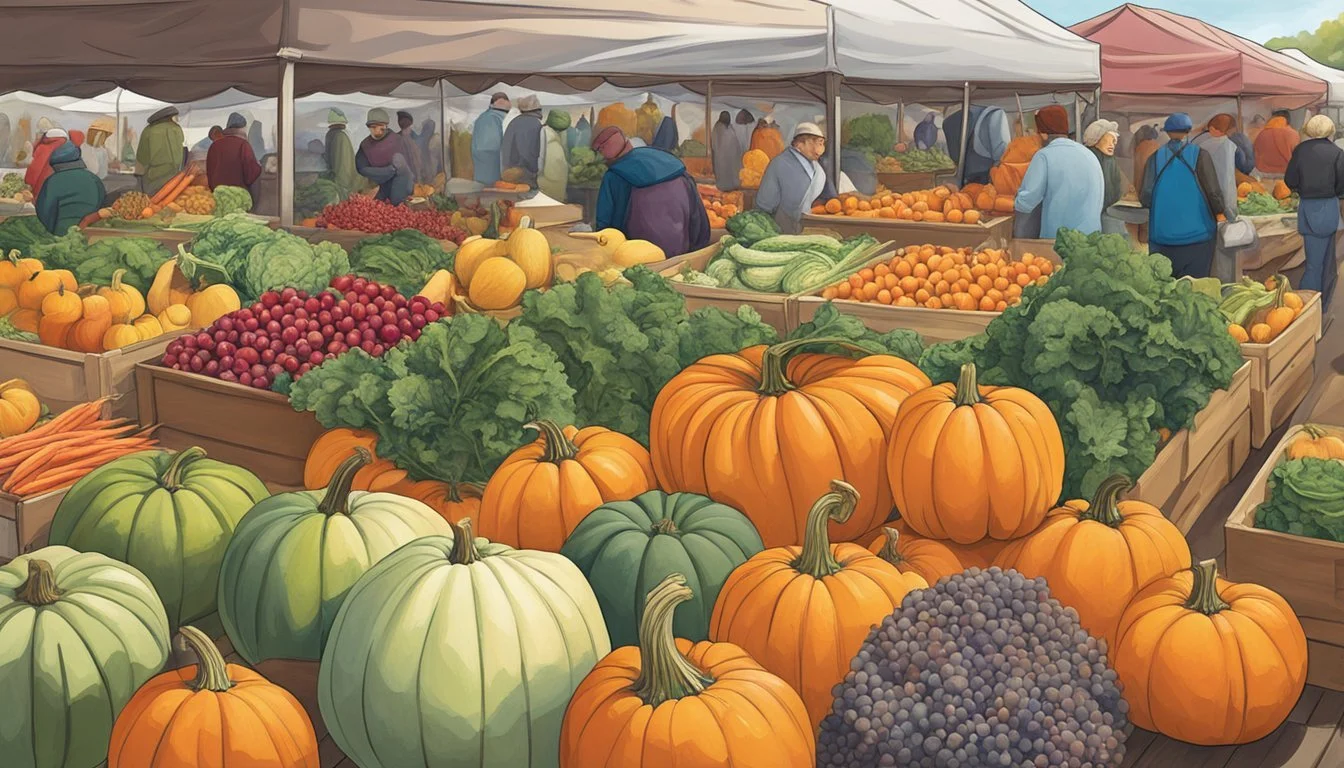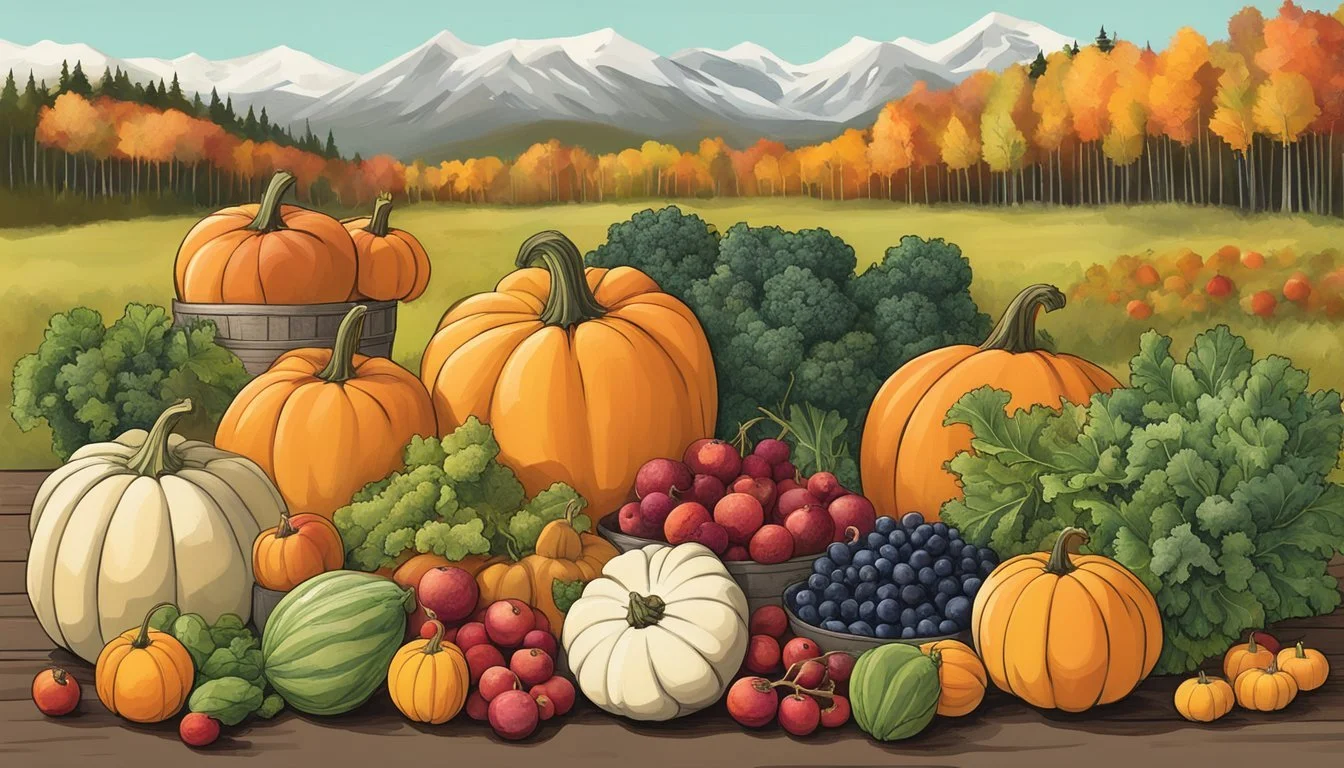Alaska Seasonal Fruit & Vegetables in October
Your Guide to Autumn Harvest
This Article is Part of our Alaska Seasonal Fruit & Veg Calendar
Alaska's growing season is notably brief, but it offers an incredible bounty of produce despite this limitation. October marks the end of this short growing period and is characterized by the harvest of hearty vegetables and late-ripening fruits. In this transitional month, Alaskan farmers work diligently to bring the last of their crops to market before the frost. The array of available produce during this time is not just a last burst of freshness before the winter but also a testament to the resilience of Alaskan agriculture.
During October, Alaskan produce like potatoes, carrots, and beets are at their peak, offering rich, earthy flavors (What wine goes well with earthy flavors?) that are ideal for hearty autumnal dishes. These storage crops not only provide fresh local options but are also essential for the winter months ahead. Kale and other cold-tolerant greens often remain available, grown with the aid of protective covering to extend their season. The short but sweet fruit season is all but over, though some hardy varieties of apples (how long do apples last?) and late berries may still be found, weather permitting.
The Alaskan landscape offers unique growing conditions that influence the taste and texture of its produce. For instance, the cooler climate and long daylight hours during the summer can intensify the sweetness of root vegetables, making them a sought-after ingredient for both chefs and home cooks alike. The commitment to seasonal eating in Alaska is not only a sustainable choice but also a celebration of the state's agricultural capabilities.
Understanding Alaska's Seasonal Produce
Alaska's environment significantly shapes its agricultural offerings, with October marking a transitional period for harvesting.
The Impact of Alaska's Climate
Alaska's climate exerts a profound influence on its agricultural production. The state's short growing season is primarily during the summer months, with long daylight hours that are beneficial for crop growth. However, fall quickly ushers in cooler temperatures as winter approaches, creating a limited time frame for cultivation. Due to these climatic conditions, the produce available in October is often the last that can be harvested before the ground freezes.
October's Place In The Harvest Calendar
As the final full month of harvest, October in Alaska is crucial for gathering the last of the season's yield before winter sets in. Farmers and gardeners work diligently to harvest and store produce that has reached maturation. Depending on the specific area, the type of crops available might vary. However, common Alaskan produce harvested during this time includes root vegetables and some hardy greens that can withstand colder temperatures.
Seasonal Vegetables in October
In the brisk Alaskan October, a range of hardy vegetables reach their peak, offering both robust flavors and essential nutrients.
Cruciferous Vegetables
Alaska’s colder temperatures in October provide the perfect conditions for cruciferous vegetables. Broccoli (how long does broccoli last?) and Brussels sprouts (how long do brussels sprouts last?) are exceptionally rich in fiber and vitamin C during this time. Cauliflower also thrives, delivering not just great taste but also a healthy dose of potassium and antioxidants.
Broccoli: Peak season from October to April.
Brussels Sprouts: Best harvested after the first frost for optimal sweetness.
Cauliflower: Versatile and nutrient-rich.
Root Vegetables and Tubers
The hearty roots and tubers of Alaska are staple foods in the fall. Carrots, beets, and potatoes are abundant and can be used in a variety of dishes. These vegetables are not just filling; they provide vital nutrients like beta-carotene in carrots and the earthy, sweet flavors found in beets, which come in both red and golden varieties.
Carrots: High in beta-carotene.
Beets: Come in rich red and golden varieties, sweet and earthy.
Potatoes: A versatile tuber, high in fiber.
Leafy Greens and Salads
Despite Alaska's cool climate, certain leafy greens flourish, offering fresh textures and flavors. Lettuce, spinach, and cabbage are all in season, providing fresh, crisp options for salads. These greens are not only flavorful but are also high in vitamins and minerals.
Lettuce: Crisp and fresh, ready for harvest.
Spinach: Tender leaves, ideal for salads or cooking.
Cabbage: Hardy and versatile, with a sweet, crisp texture.
Other Seasonal Vegetables
October also sees a variety of other vegetables that are ripe for the picking. Celery, onions, and peas are all harvested during this time. While winter squash presents a sweet, nutty flavor that is perfect for hearty autumn meals.
Celery: A crunchy, low-calorie vegetable rich in fiber.
Onions: A foundational vegetable for many dishes, rich in flavor.
Peas: Sweet and tender, offering a burst of flavor.
Winter Squash: Deliciously sweet and perfect for roasting or soups.
Seasonal Fruits in October
October in Alaska brings a limited but vibrant variety of fruits ripe for the picking. These fruits offer a blend of taste and nutrition, perfect for incorporating into fall recipes.
Tree Fruits
Apples: A staple of the Alaskan fall, apples are abundant in October. Varieties available during this month range from the tart "Granny Smith" to the sweet "Fuji," each with its own unique applications in cooking and baking. Apples are known for their versatility and are packed with fiber and vitamin C.
Pears: Harvested in the fall, pears offer a delicate, sweet flavor that complements both sweet and savory dishes. They are a nutritious choice, providing essential vitamins and fiber.
Berries and Uncommon Varieties
Cranberries: Cranberry bogs yield their fruit in October, and these tart berries are often celebrated for their vitamin C content and antioxidant properties. They can be used in a variety of recipes, from sauces to desserts.
Lingonberries: Although less common, lingonberries ripen in Alaska during late summer and into early fall, carrying over sometimes into October. They are similar to cranberries but with a slightly sweeter and more complex flavor, commonly used in jams and preserves.
Harvest and Storage Tips
October in Alaska presents an opportunity for harvesting a bounty of fruits and vegetables that thrive in colder climates. Proper techniques ensure that the produce such as pumpkins, parsnips, and pears maintain their quality post-harvest.
Best Practices for Vegetables
Pumpkins and butternut squash: (how long does butternut squash last?)Harvest these gourds when their skin turns hard and they have developed a deep, solid color. Cut them from the vine leaving several inches of stem attached, which prevents decay. Store them in a cool, dry place—they can last up to three months.
Root vegetables (parsnips, rutabagas): Remove any soil and cut the tops off to about 1 inch above the root to reduce moisture loss. Store them in a cool, humid environment. Root vegetables can be stored in sand or peat moss to keep them moist and firm.
Zucchini and spaghetti squash: Harvest these before the first frosts. Zucchini should be firm and not oversized. Spaghetti squash should sound hollow when tapped. Store in a cool, well-ventilated area. Refrigeration can reduce their lifespan; they typically last one to two weeks.
Preservation Techniques for Fruits
Pears: Pears should be picked when mature but still firm; they will ripen off the tree. Store pears at room temperature until ripe, then refrigerate to slow further ripening.
Grapes: Harvest grapes when they are firm, plump, and fully colored. They contain natural acids that help keep them fresh. Store in a shallow container, covered with a perforated plastic bag in the refrigerator to maintain humidity.
Lemon and other citrus fruits: While not native to Alaska, if grown in controlled conditions or greenhouses, they should be harvested when fully colored and firm. Store citrus fruits in a mesh or other breathable bags in the refrigerator's crisper where they can last several weeks.
Using these specific techniques will maximize freshness and extend the shelf-life of Alaska's October produce, allowing one to enjoy the harvest long after the growing season ends.
Cooking and Usage Ideas
In October, Alaska's harvest offers a bounty ripe for culinary creativity, presenting an opportunity to showcase the season’s peak flavors in dishes.
Main Dishes
One can savor the taste of Alaska with main dishes featuring roasted root vegetables like sweet potatoes, which hit their peak in October. They provide a sweet, earthy flavor ideal for roasting with salt and ginger. Chicken curry with apples offers a savoury, tangy complement to the warm spices of the curry.
Roasted Sweet Potatoes
Ingredients: Sweet potatoes, olive oil, ginger, salt.
Method: Cube and toss in oil and spices, roast until tender.
Chicken Curry with Apples
Ingredients: Chicken, apples, curry spices, coconut milk.
Method: Brown chicken, add spices and apples, simmer in coconut milk.
Salads and Sides
Alaskan salads and sides in October can include ingredients like freshly harvested broccoli, which can be served raw or lightly blanched in salads or as a hearty braised side dish. Cobbler salads combine the sweetness of fresh fruits like cranberries with savory greens and a tangy dressing.
Broccoli Salad
Ingredients: Fresh broccoli, cranberries, salad greens, dressing.
Method: Mix raw or blanched broccoli with greens, add cranberries and toss with dressing.
Braised Broccoli
Ingredients: Broccoli, broth, aromatic spices.
Method: Sauté broccoli with spices, then braise in broth until tender.
Desserts and Preserves
Alaska’s apple harvest in October is perfect for creating desserts and preserves, from classic apple tarts to apple sauce that captures the freshness of the fruit. The end of berry season is the right time to make preserves, ensuring flavors are preserved beyond their peak.
Apple Tarts
Ingredients: Apple slices, pastry dough, cinnamon, sugar.
Method: Lay apple slices on pastry, sprinkle with cinnamon and sugar, bake until golden.
Berry Preserves
Ingredients: Berries, sugar, pectin (how long does pectin last?).
Method: Cook berries with sugar and pectin, can for long-term storage.
Health Benefits and Nutrition
October in Alaska presents an array of seasonal fruits and vegetables that are not only rich in flavors but also offer a multitude of health benefits. The consumption of these seasonal foods provides the body with essential nutrients necessary for maintaining good health.
Honey, while not a fruit or vegetable, is a natural sweetener abundant during this time and is known for its antioxidants. It can contribute to heart health and contains antibacterial properties. Kale, a leafy green, is revered as a superfood, laden with vitamin C and potassium, and is beneficial for bone health and digestion due to its high fiber content.
Butternut squash stands out in the autumnal harvest with its sweet, nutty taste and is a good source of vitamins A and E, fiber, and potassium. Similarly, pears provide dietary fiber that promotes a healthy digestive system and are rich in vitamin C. Beans serve as a hearty staple, offering protein, fiber, and a variety of minerals, supporting overall bodily functions.
Alaskan leeks, peppers, and radicchio offer unique flavors and are packed with vitamins and antioxidants. These vegetables can bolster the immune system, reduce inflammation, and support heart health. Pomegranates and berries, such as blueberries and blackberries, come into season and are known for high antioxidant levels that help fight oxidative stress.
Despite not being traditionally associated with Alaska, nor being in season in October, it’s worth mentioning the power of including superfoods in one’s diet. For instance, balanced consumption of beef and pork in dietary practices can provide protein and iron, though these are typically available year-round and are not specific to the season.
Table 1: Nutritional Highlights of October Produce in Alaska
Food Item Key Nutrients Honey Antioxidants, Natural Sugars Kale Vitamin C, Vitamin K, Potassium, Fiber Butternut Squash Vitamins A and E, Fiber, Potassium Pear Dietary Fiber, Vitamin C Beans Protein, Fiber, Iron Leeks Vitamin A, Vitamin C Peppers Vitamin C, Antioxidants Radicchio Vitamin K, Antioxidants Pomegranate Antioxidants, Vitamin C, Fiber Blueberries Antioxidants, Vitamin C Blackberries Vitamin C, Fiber, Vitamin K
In conclusion, incorporating Alaska’s seasonal fruits and vegetables in October offers ample health benefits, from immune support to anti-inflammatory properties. This is a strategic, tasteful way to align one's diet with the seasonal rhythms and enjoy the nutritional bounty it provides.
Shopping and Selecting Produce
When shopping for produce in Alaska during October, one must be strategic in choosing locations and aware of the seasonal availability. The state offers a range of vegetables and fruits that are at their peak, including pumpkins, kale, spinach, and beets.
Farmers' Markets and Local Farms
Farmers' Markets: Farmers' markets are ideal for accessing October's freshest produce. Shoppers can find a variety of options, including:
Pumpkins: A staple of fall, perfect for carving and cooking.
Kale and Spinach: Leafy greens known for their nutritional value.
Zucchini and Tomatoes: Though nearing the end of their season, these are often still available from greenhouse growers.
Local Farms: Visiting local farms can be a rewarding experience for buying produce and supporting the community. Key factors to consider:
Availability: Confirm the farm's operating dates and what produce is currently available.
Variety: Some farms may specialize in certain types of produce like root vegetables, including beets.
Sustainability: Inquire about the farm's practices to ensure they align with one's values.
Understanding Labels and Seasonality
Labels: Shoppers should understand labels to make informed choices. Key labeling terms include:
Organic: Produce grown without synthetic pesticides or fertilizers.
Locally Grown: Indicates the produce was grown within a specific area, reducing travel time and supporting local producers.
Seasonality: A seasonality guide is beneficial for shopping. October produce highlights encompass:
Root vegetables like beets, known for their earthy flavor and versatility.
Hardy greens, which may include kale and spinach, offering robust flavor and nutrients.
In conclusion, being informed about the local markets, farms, and seasonally available produce allows for optimal selection of fresh, nutritious October fruits and vegetables in Alaska.








